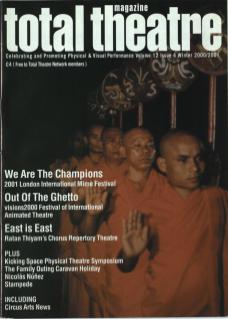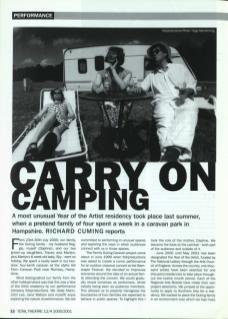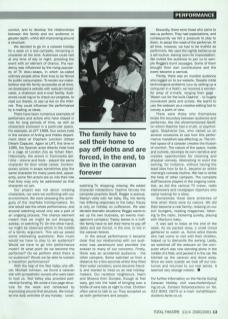From 23-30 July 2000, our family, the Outing family – my husband Reggie, myself (Daphne), and our two grown-up daughters, Tracey and Marilyn, plus Marilyn's six week-old baby, Sky – went on holiday. We spent a lovely week in our two-door, four-berth caravan at the idyllic Hill Farm Caravan Park near Romsey, Hampshire.
What distinguished our family from the other holidaymakers was that this was a Year of the Artist residency by our performance company fishproductions. We (Sally Mann, John Lee, Jane Watson and myself) enjoy exploring the nature of performance. We are committed to performing in unusual spaces and exploring the ways in which audiences connect with us in those spaces.
The Family Outing Caravan project came about in June 1999 when fishproductions was asked to create a comic performance for an outdoor classical concert at the Barnstaple Festival. We decided to improvise scenarios around the idea of an actual family attending the concert. We would gradually reveal ourselves as performers, whilst initially being seen as audience members. This allowed us to playfully transgress the boundaries of how families are expected to behave in public spaces. To highlight this I took the role of the mother, Daphne. We became the fools at the carnival – both part of the audience and outside of it.
June 2000 until May 2001 has been designated the Year of the Artist, funded by The National Lottery through the Arts Council of England. Across the country, one thousand artists have been selected for one thousand residencies to take place throughout the twelve-month period. Each of the Regional Arts Boards have made their own project selections. We jumped at the opportunity to apply to Southern Arts for a residency. We wanted to place the Outing family in an environment over which we had more control, and to develop the relationships between the family and our audience in greater depth, whilst still improvising around a structure.
We decided to go on a caravan holiday for a week on a real campsite, remaining in character all the time. Audiences could visit at any time of day or night, providing the event with an element of chance. The residency was influenced by the rising popularity of TV docu-soaps, in which so-called ordinary people allow their lives to be filmed for public consumption. To render our make-believe real-life family accessible at all times, we developed a website with webcam broadcasts, a chatroom and e-mail facility. Audiences could log on to check our progress, to read our diaries, to see us live on the Internet. They could influence the performance by e-mailing us ideas.
There have been numerous examples of performers and actors who have stayed in role for long periods of time, as well as characters enclosed in a particular space. For example, at LIFT 1999, four actors lived in the window of Arding and Hobbs department store at Clapham Junction (Urban Dream Capsule). Again at LIFT, this time in 1985, the Spanish actor Alberto Vidal lived in a cage at London Zoo as 'Urban Man'. Historically, the actors in Commedia dell'Arte – clowns and fools – played the same character for their whole career. Contemporary actors in soaps sometimes play the same character for many years and, apparently, some film actors are so into their role that they may only be addressed as that character on set.
Our project was not about creating characters, nor were we conflicting with our environment. We were stressing the ambiguity of the real/fake holidaymakers. No one would see the whole performance, and anyone watching would only see a part of an ongoing process. The chance element meant that we might be out shopping, asleep, or watching TV. On the other hand, we might be observed whilst in the middle of a family argument. This set-up posed some interesting questions. How much would we have to play to an audience? Would we have to go into performance mode? At what point do we become the performer? Do we perform when there is no audience? Would we be able to sustain a marathon performance?
With the help of the Test Valley arts officer, Michael Johnson, we found a caravan site with sympathetic owners who were keen to host us. Test Valley also provided partnership funding. We wrote a two-page structure for the week and rehearsed by improvising around that structure. We included the daily activities of any holiday – lunch, watching TV, shopping, relaxing. We added character interactions: Daphne fancies the campsite proprietor Geoff, Reggie is jealous; Marilyn visits with her baby, Sky, the family has differing responses to the baby; Tracey is only on holiday on sufferance. We also devised dramatic situations: Reggie wants to set up his own business, an events management company; Tracey leaves in a huff; the family have to sell their home to pay off debts and are forced, in the end, to live in the caravan forever.
In the actual performance it became clear that our relationship with our audience was paramount and provided the answer to many of our concerns. Firstly, there was an accidental audience – the other campers. Some watched us from a distance for a few seconds whilst they filled their water canisters; some became friendly and started to treat us as real holiday makers. Our next-door neighbours, Nairn and Sheena from Dundee, though at first wary, got into the habit of bringing over a bottle of wine late at night to chat. Children often came to talk to us. They accepted us as both performers and people.
Secondly, there were those who came to see us perform. They had expectations, and consequently we felt a pressure to play to them, to adopt the mask of the performer. At all times, however, we had to be truthful as performers. We used the nightly barbecue as a set routine, leaving room for improvisation. We invited the audience to join us to sample Reggie's burnt sausages. Some of them brought their own contributions and the event became a carnival.
Thirdly, there was an invisible audience who logged on to our website. Despite initial technological problems (you try setting up a computer in a field!), we received a wonderful array of e-mails, ranging from gags – 'Watch out for the bulls, Daphne' – to hugely convoluted plots and scripts. We learnt to use the webcam as a creative editing tool to convey a point of view.
There were those who themselves broke the boundary between audience and performer, like the afore-mentioned Geoff, on whom Daphne had a crush, or psychologist, Stephanie Cox, who visited us on several occasions to see how this performance marathon was affecting us. The limited space of a caravan creates the illusion of comfort. The nature of the space, inside and outside, develops its own narrative and creates opportunities for clowning and physical comedy. Attempting to erect the awning, for instance, without having the least idea how to do it, became an entire morning's comedy routine. We had to enlist the help of other campers. The campsite staff became players in the ongoing narrative, as did the various TV crews, radio interviewers and newspaper reporters who came looking for a story.
Sometimes there were stretches of time when there were no visitors. We did then become a real family, relaxing on our sun loungers, reading magazines, listening to the radio, bickering quietly, playing with Marilyn's baby.
It was sad to leave at the end of the week. As we packed away, a small crowd gathered to watch us. Some artist friends who had come to visit with their children, helped us to dismantle the awning. Lastly, we switched off the webcam on the computer which was now standing alone in the middle of a field, and packed it in the car. We hitched up the caravan and drove away. Once we were outside we took off our costumes and returned to our real selves. It seemed very strange indeed.
For further information on the Family Outing Caravan Holiday visit www.thefamilyouting.co.uk


